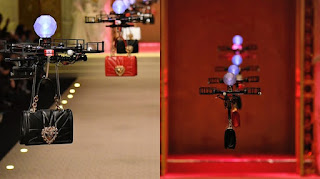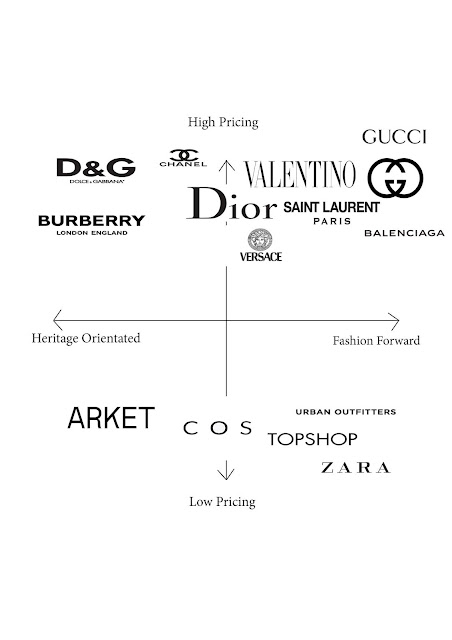Dolce & Gabbana PESTEL Analysis
Political
With fashion becoming more and more globalised, fashion brands are now accessible to new markets - Asia being one them. However, when Dolce & Gabbana took an initial step towards strengthening their relationship with China, it understandably backfired due their racist comments. D&G's 'Great Show' that was supposed to take place was supposedly forced to be cancelled by the China's local government authorities.
This highlights the profound importance of brands being politically aware when trying to access new markets, often there can be major social, economic and even legal consequences by many governments.
Economic
Brands, like all industries, depend on the state of the economy. Fluctuations in the economy, also results in fluctuations on the brand, whether that be a rise or fall in sales, or being able to make new products and the quality of their campaigns and runway shows. Thus, this will always affect the amount of money that Dolce & Gabbana will make as a brand.
On the other hand, for Dolce & Gabbana, their controversies can also effect their sales. A Business of Fashion article stated "according to Bain & Company’s latest report on the luxury market, Chinese consumers account for an estimated 33 percent of global luxury goods spend, a share that is likely to hit 46 percent by 2025". The future of a large amount of D&G's market heavily depends on the support of China.
Social
The rise of social media throughout the past decade has meant that brands are now heavily dependent on using social media to sell their brand to consumers. However, recently this has meant that brands need to advertise through social media influencers and celebrities in order to promote their products. People - especially millennials - are now more likely to buy from and support a brand if they see an influencer promoting their products.
Dolce & Gabbana have been at the forefront of using influencers both in the runway shows and their campaigns. This has meant that younger people have become more engaged with the brand due to their use of social media influencers and celebrities such as Cameron Dallas, Sofia Richie, Ashley Graham and Luka Sabbat.
Social media and influencers is now one of the most vital marketing ploys for fashion brands.
Technological
Following on from the impacts of social media on brands, many are now moving online. Online sales for fashion brands are on an all time high, meaning that brands need to make sure that their websites are easy to use yet still fitting with the image so sales continue to follow
On the other hand, brands are trying to merge their fashions with technology, Dolce & Gabbana being one of them. For D&G's Autumn/Winter 18 show, the creative directors sent around seven drones down the runway, each carrying leather handbags, as well as the models. The mix of fashion and technology not only show how brands are striving to bring the newest and somewhat coolest elements to the runway, but also indicating that there will be a major shift towards interlinking fashion with technology in the near future.
Environmental
The fashion industry is known as being the second most polluting industry, thus there is many environmental problems that comes with fashion brands. For luxury brands, one of the main environmental problems is waste products. Many of these brands, any waste products are burnt instead of being reduced in sales, as they do not want the pieces to be devalued.
Nevertheless, some fashion brands are changing and publicly announcing their steps on becoming more sustainable. In 2018, Burberry announced that they will stop burning the unsold clothing and instead choosing to recycle and repair products. As well as this, the brand any others including Gucci and Calvin Klein have stopped the use of real fur, with Gucci's chief executive and president tell the Business of Fashion that he does not think "[fur] still modern".
Yet, Dolce & Gabbana has not explicitly stated anything about their sustainability, instead stating on their Code of Ethics that having "respect for the environment is a fundamental value that the company peruses by adopting sustainable conduct when performing it activities and supporting initiatives and and projects to combat climate change". The ambiguous statement made by Dolce & Gabbana perhaps implies that they are still behind other brands in sustainable and environmentally friendly changes that will help to make the fashion industry as a whole less polluting.
References
Berzehna, V. (2018). Bits & Bytes | Dolce & Gabbana Sends Drones Down the Runway, JD.com's Blockchain Accelerator. Retrieved from https://www.businessoffashion.com/articles/bits-bytes/bits-bytes-dolce-gabbana-sends-drones-down-the-runway-jd-coms-blockchain-accelerator
Hall, C., & Suen, Z. (2018). Dolce & Gabbana China Show Cancelled Amid Racism Outcry. Retrieved from https://www.businessoffashion.com/articles/news-analysis/racism-accusations-force-dolce-gabbana-to-cancel-chinese-fashion-show
Kollewe, J. (2018). Burberry to stop burning unsold items after green criticism. Retrieved from https://www.theguardian.com/business/2018/sep/06/burberry-to-stop-burning-unsold-items-fur-after-green-criticism
Shannon, S. (2017). Gucci Bans Fur: ‘It’s Not Modern’. Retrieved from https://www.businessoffashion.com/articles/news-analysis/gucci-bans-fur-saying-its-not-modern
Retrieved on January 26 2019 from http://www.dolcegabbana.com/corporate/en/group/code-of-ethics.html
With fashion becoming more and more globalised, fashion brands are now accessible to new markets - Asia being one them. However, when Dolce & Gabbana took an initial step towards strengthening their relationship with China, it understandably backfired due their racist comments. D&G's 'Great Show' that was supposed to take place was supposedly forced to be cancelled by the China's local government authorities.
This highlights the profound importance of brands being politically aware when trying to access new markets, often there can be major social, economic and even legal consequences by many governments.
Economic
Brands, like all industries, depend on the state of the economy. Fluctuations in the economy, also results in fluctuations on the brand, whether that be a rise or fall in sales, or being able to make new products and the quality of their campaigns and runway shows. Thus, this will always affect the amount of money that Dolce & Gabbana will make as a brand.
On the other hand, for Dolce & Gabbana, their controversies can also effect their sales. A Business of Fashion article stated "according to Bain & Company’s latest report on the luxury market, Chinese consumers account for an estimated 33 percent of global luxury goods spend, a share that is likely to hit 46 percent by 2025". The future of a large amount of D&G's market heavily depends on the support of China.
Social
The rise of social media throughout the past decade has meant that brands are now heavily dependent on using social media to sell their brand to consumers. However, recently this has meant that brands need to advertise through social media influencers and celebrities in order to promote their products. People - especially millennials - are now more likely to buy from and support a brand if they see an influencer promoting their products.
Dolce & Gabbana have been at the forefront of using influencers both in the runway shows and their campaigns. This has meant that younger people have become more engaged with the brand due to their use of social media influencers and celebrities such as Cameron Dallas, Sofia Richie, Ashley Graham and Luka Sabbat.
Social media and influencers is now one of the most vital marketing ploys for fashion brands.
Technological
Following on from the impacts of social media on brands, many are now moving online. Online sales for fashion brands are on an all time high, meaning that brands need to make sure that their websites are easy to use yet still fitting with the image so sales continue to follow
On the other hand, brands are trying to merge their fashions with technology, Dolce & Gabbana being one of them. For D&G's Autumn/Winter 18 show, the creative directors sent around seven drones down the runway, each carrying leather handbags, as well as the models. The mix of fashion and technology not only show how brands are striving to bring the newest and somewhat coolest elements to the runway, but also indicating that there will be a major shift towards interlinking fashion with technology in the near future.
Legal
A large problem that comes with luxury brands, is counterfeit goods. Although they are often illegal under trademark laws, many people are still choosing to buy these fake designer products in place of the real items, often due to them being much cheaper alternatives. However, it is most likely that this is always going to be a legal problems for luxury brands, as many places are still finding loopholes and continuing to make money on copies.
The fashion industry is known as being the second most polluting industry, thus there is many environmental problems that comes with fashion brands. For luxury brands, one of the main environmental problems is waste products. Many of these brands, any waste products are burnt instead of being reduced in sales, as they do not want the pieces to be devalued.
Nevertheless, some fashion brands are changing and publicly announcing their steps on becoming more sustainable. In 2018, Burberry announced that they will stop burning the unsold clothing and instead choosing to recycle and repair products. As well as this, the brand any others including Gucci and Calvin Klein have stopped the use of real fur, with Gucci's chief executive and president tell the Business of Fashion that he does not think "[fur] still modern".
Yet, Dolce & Gabbana has not explicitly stated anything about their sustainability, instead stating on their Code of Ethics that having "respect for the environment is a fundamental value that the company peruses by adopting sustainable conduct when performing it activities and supporting initiatives and and projects to combat climate change". The ambiguous statement made by Dolce & Gabbana perhaps implies that they are still behind other brands in sustainable and environmentally friendly changes that will help to make the fashion industry as a whole less polluting.
References
Berzehna, V. (2018). Bits & Bytes | Dolce & Gabbana Sends Drones Down the Runway, JD.com's Blockchain Accelerator. Retrieved from https://www.businessoffashion.com/articles/bits-bytes/bits-bytes-dolce-gabbana-sends-drones-down-the-runway-jd-coms-blockchain-accelerator
Hall, C., & Suen, Z. (2018). Dolce & Gabbana China Show Cancelled Amid Racism Outcry. Retrieved from https://www.businessoffashion.com/articles/news-analysis/racism-accusations-force-dolce-gabbana-to-cancel-chinese-fashion-show
Kollewe, J. (2018). Burberry to stop burning unsold items after green criticism. Retrieved from https://www.theguardian.com/business/2018/sep/06/burberry-to-stop-burning-unsold-items-fur-after-green-criticism
Shannon, S. (2017). Gucci Bans Fur: ‘It’s Not Modern’. Retrieved from https://www.businessoffashion.com/articles/news-analysis/gucci-bans-fur-saying-its-not-modern
Retrieved on January 26 2019 from http://www.dolcegabbana.com/corporate/en/group/code-of-ethics.html



Comments
Post a Comment